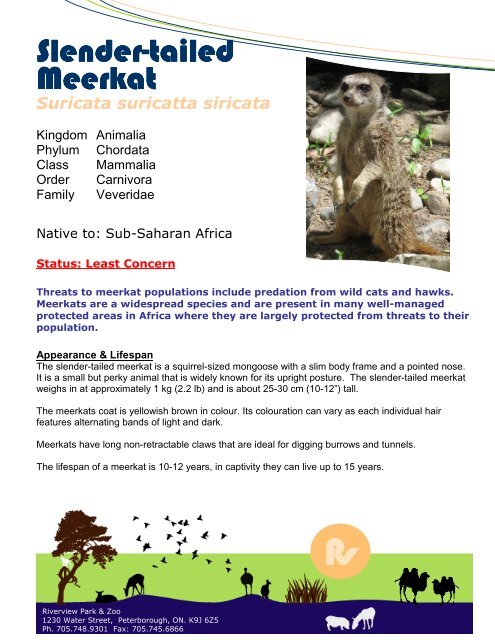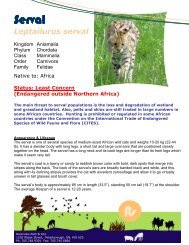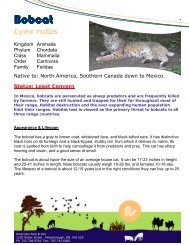Slender-tailed Meerkat - Peterborough Utilities
Slender-tailed Meerkat - Peterborough Utilities
Slender-tailed Meerkat - Peterborough Utilities
Create successful ePaper yourself
Turn your PDF publications into a flip-book with our unique Google optimized e-Paper software.
<strong>Slender</strong>-<strong>tailed</strong><strong>Meerkat</strong>Suricata suricatta siricataKingdom AnimaliaPhylum ChordataClass MammaliaOrder CarnivoraFamily VeveridaeNative to: Sub-Saharan AfricaStatus: Least ConcernThreats to meerkat populations include predation from wild cats and hawks.<strong>Meerkat</strong>s are a widespread species and are present in many well-managedprotected areas in Africa where they are largely protected from threats to theirpopulation.Appearance & LifespanThe slender-<strong>tailed</strong> meerkat is a squirrel-sized mongoose with a slim body frame and a pointed nose.It is a small but perky animal that is widely known for its upright posture. The slender-<strong>tailed</strong> meerkatweighs in at approximately 1 kg (2.2 lb) and is about 25-30 cm (10-12”) tall.The meerkats coat is yellowish brown in colour. Its colouration can vary as each individual hairfeatures alternating bands of light and dark.<strong>Meerkat</strong>s have long non-retractable claws that are ideal for digging burrows and tunnels.The lifespan of a meerkat is 10-12 years, in captivity they can live up to 15 years.Riverview Park & Zoo1230 Water Street, <strong>Peterborough</strong>, ON. K9J 6Z5Ph. 705.748.9301 Fax: 705.745.6866
Behavior & Reproduction<strong>Slender</strong>-<strong>tailed</strong> meerkats are very social animals who live in colonies. Individuals in the group playdifferent roles within the structured community. For instance, one meerkat may keep guard over thecolony from a safe place close by. If a predator is spotted, the entire colony is warned with a shrillcall which signals others to run for cover. Other individuals forage for food or group together to huntwhile using an array of grunts, purrs and other calls to communicate to one another.<strong>Meerkat</strong> family groups dig and use a network of underground tunnels and burrows. This allows thegroup to stay cool in such a hot environment. Alpha females will give birth to 2-4 young every yearand utilize one of the underground rooms to do so.Family members all take part in raising the young by teaching them to forage and to avoid predatorsthrough play.Ecology & ConservationThe slender-<strong>tailed</strong> meerkat is widespread in the western parts of southern Africa including Angola,Botswana, Namibia and South Africa. Within this range the numbers vary and are greatly influencedby rainfall and predation.<strong>Meerkat</strong>s live in open areas with short grasses and some woody growth and avoid desert andforested areas. They can often be found near the stone koppies (rocky hills) of the African deserts.They are carnivorous animals who feed on invertebrates. They will eat insects, spiders, grubs andsometimes on small vertebrates like lizards, snakes, birds, fruits and berries.At the zoo, meerkats feed on a special meat diet provided by the Toronto Zoo, mixed fruit andvegetables, adult-sized mice, crickets and mealworms.Did You Know?1. All adult meerkats pitch in to help educate the young in hunting and survival techniques.2. Young meerkats are so fearful of predatory birds that even airplanes will send them diving forcover.3. In Zimbabwe and Zaire, the meerkat is known as the "Sun Angel" and protects villages from the"Moon Devil" or werewolf.Riverview Park & Zoo1230 Water Street, <strong>Peterborough</strong>, ON. K9J 6Z5Ph. 705.748.9301 Fax: 705.745.6866





